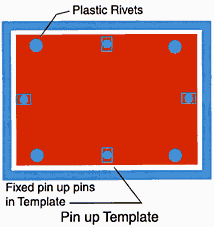 |
|
Volume 1 Number 1 / Editor: Steve Scheinpflug / January/February 1997 |
|
|
Advantages of Plastic Riveting Common Questions Asked By Our Customers Employee Anniversaries The Toy Drive Was A Huge Success! |
Advantages of Plastic Riveting
Rivets for laminating six layer and above offer certain advantages to a multiplayer manufacture. Lower lamination plate costs, more flexible panel size options and now excellent registration is available using the new plastic riveting system by Multiline Technology. This new plastic riveting system has been developed in a joint effort with Cedal “Adara Presses” of Italy and Multiline Technology. Thes new plastic rivets, which
hold the multiplayer package in registration during lamination, allow for better accuracy than old conventional shoe machine brass
eyelets. Inner layers can be processed through a post etch punch that will punch four centerline slots and four round holes (other tooling patterns are also possible with the system). The inner layers are held in registration on a template via four centerline slotted tooling pins. Plastic rivets are then placed in the four round holes. Upon completion of each board lay up, the operator places the template in the ultrasonic rivet machine. The machine is activated and the plastic rivets are ultrasonically formed. Registration is held by the four slots during the lay up and the rivet forming process during which ther is no side loading. Side loading of expanding eyelets is one of the major drawbacks of conventional brass eyeleting. The plastic rivets are made of a thermoplastic and have a higher melt
point than the prepreg being used. This insures that the registration
is held while they are at the gel stage of the repreg during the lamination
process. Home | About Us | Staff | Directions | Products | News | Trade Shows | Literature | Employment | Contact Us
© 2002 Multiline Technology
|

